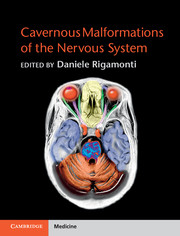Cavernous malformations (CM) are problematic for neurologists in day-to-day practice because they are common and often, but not always, harmless: their morbidity is uncomfortably similar to that of the means by which they may be treated. CM are vascular anomalies lacking shunt, major feeding artery or draining vein, their walls not possessing either smooth muscle or elastic fibres. They are known variously as cavernomas, cavernous haemangiomas and cavernous angiomas.
This book, ‘Cavernous Malformations of the Nervous System’ edited by Professor Daniele Rigamonti is a well researched and comprehensive text. There are 40 contributing authors from numerous international centres, providing an array of research and clinical experience. They cover current concepts in CM practice. The volume is presented very systematically in four sections with 19 chapters.
In Section 1 the authors focus on the structural pathology, epidemiology and molecular genetics of CM. They describe mutations in three genes which are linked to familial CM, inherited as autosomal dominant traits. One criticism is that these genetics subsections sometimes strayed from comprehensive to repetitive.
In Section 2, the authors detail the clinical presentations of CM and the most sensitive diagnostic imaging modalities to be used for initial assessment and for follow-up. The authors provide insights into the safety of various drugs that may be used in the presence of CM. They also give well-reasoned recommendations about activity restriction in CM. This is very practical information, potentially of great utility in advising patients with CM.
Section 3 discusses the management of CM including, both conservative and surgical, while the final section provides an update on genetic counselling in CM.
Cavernous malformations, from basic structure to diagnosis and management, are both intriguing and challenging to clinicians. With the advent of precise neuroimaging, patients asymptomatic from CM are being identified more frequently. This book attractively and effectively provides an update on current research and clinical practice as to the best approaches with both symptomatic and asymptomatic CM. It also has sufficient scientific rigour to be a reminder of how little we know of the subject. Vascular neurologists in particular will find this book very valuable.

